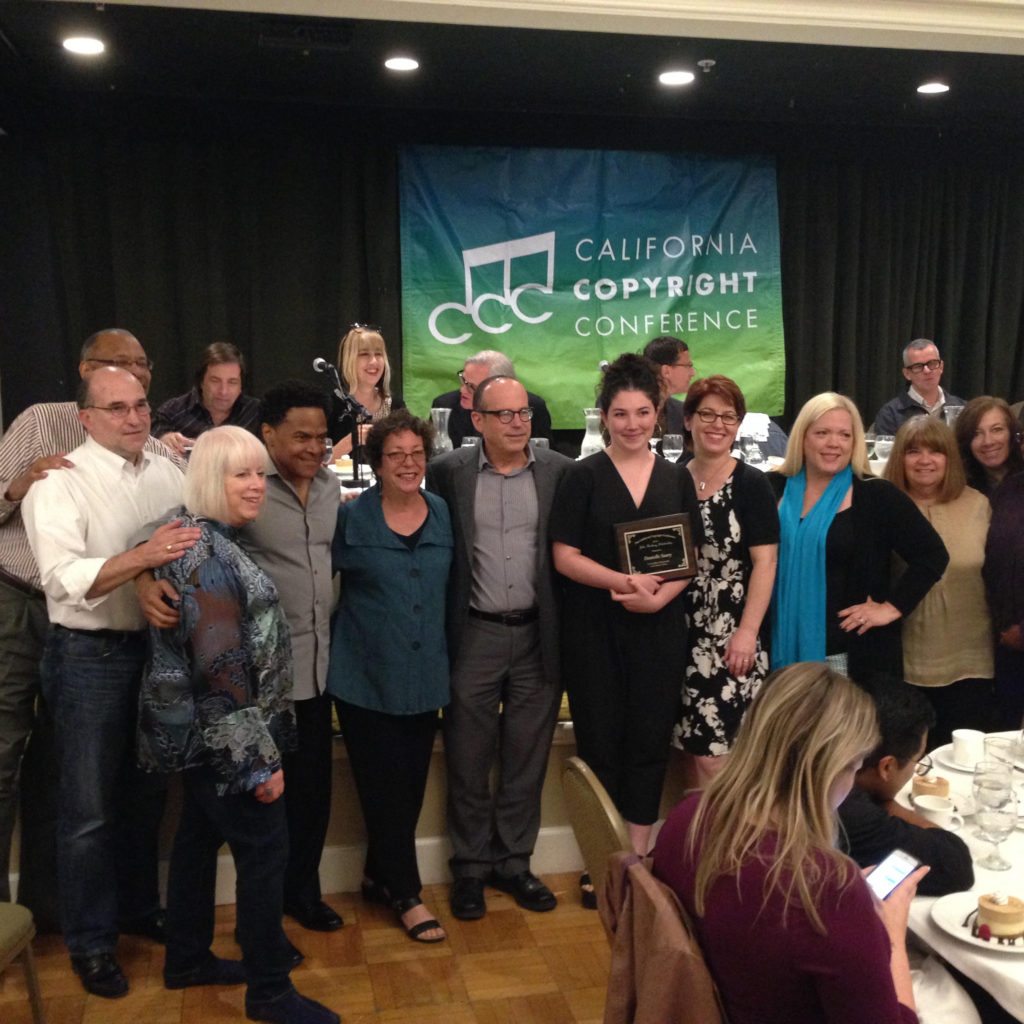“The scholarship committee is happy to present its unanimous recommendation for the 2016 John Braheny Scholarship recipient, Danielle Soury, a sophomore from USC. Danielle stands head and shoulders above the other applicants. Having an impressive academic background (she possesses a 3.96 GPA), she has still made time to take internships at Sony/ATV and Chop Shop Music Supervision. When she graduates, Danielle would like to take on a position in music supervision that allows her to empower up and coming women artists. Her extracurricular activities include acting as business manager for one of her school’s a cappella groups, working as social media manager for the student radio station, and working in community outreach programs for the performing arts. She comes highly recommended by Prof. Mark Goldstein at USC who said she is one of the best students he has ever had and predicts that she is destined for great things. Her supervisor at Chop Shop, Kasey Truman, also gave her an outstanding recommendation.” — California Copyright Conference
Songwriters Musepaper – Volume 10 Issue 10 – October 1995 – Songwriters Expo 18
Songwriters Musepaper – Volume 6 Issue 4 – April 1991 – Interview: Dean Pitchford
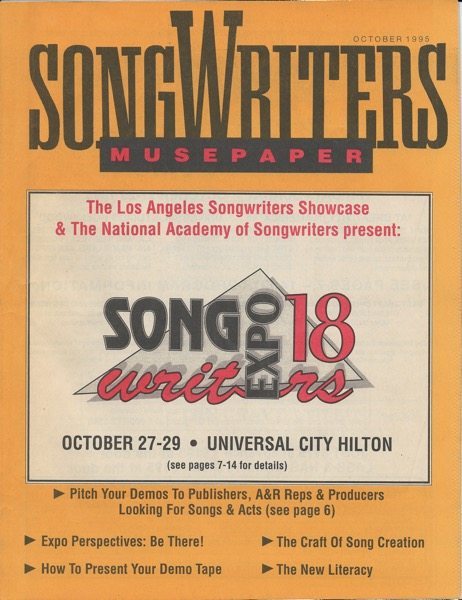
JB#: C000000062-023-001

JB #: C000000062-023-002
Table of Contents
(Digitally converted text. Some errors may occur)
SONGWRITERS EXPO 18-SCHEDULE AND WRITE UPS 7-14
Start mapping out your plans for three days of the most intensive learning, schmoozing and pitching opportunities for songwriters on the planet!
PERSONAL PERSPECTIVE-
HOW TO PRESENT YOUR DEMO TAPE 15
David Letterman, take a seat! LASS co-founder/director John Braheny offers up his own Top Ten List…of demo presentation tips for the serious songwriter.
THEORETICALLY SPEAKING-
THE CRAFT OF SONG CREATION 17
Diligent rehearsal can make all the difference between getting it written and getting it right, says Austin rocker and Harvard scholar Lindsey Eck.
UPBEAT-
EXPO PERSPECTIVES: BE THERE! 18
Expo veteran Dan Kimpel explains it all for you.
MUSICAL NOTES-
THE NEW LITERACY 19
Harriet Schock shows how a group of songwriter/singers representing a NARAS outreach program, Grammy In The Schools®, bring the new literacy of songwriting into high schools proving that “even kids” will listen if what is said is clear, interesting and worth being heard.
LASS NEWS MEMBER
NEWS-NOTEWORTHY-MUSICAL CHAIRS 4
News about classes, biz events, where your favorite publishers and A&R reps are this month, good stuff about our Members and Pickups.
WEEKLY SHOWCASE SCHEDULE 6
Cassette RouletteTM (publisher song critiques) and Pitch-A-ThonTM (producers and record company reps looking for songs and acts).
From the Acting Archivist…
Much like the Songmine columns posted earlier, the archives contain a large collection of Songwriter Musepaper publications. With this posting, I am beginning a project to scan the cover and table of contents of each issue and then OCR (convert the scanned picture to text) the table of contents in order to make it searchable. I don’t yet have the staff necessary to create complete scanned issues of the Museupaper, but if there is interest in a particular article or interview, I can scan that and make it available here.
Douglas E. Welch, douglas@welchwrite.com
Previously in Songwriters Musepaper:
- Songwriters Musepaper – Volume 6 Issue 4 – April 1991 – Interview: Dean Pitchford
- Songwriters Musepaper – Volume 10 Issue 1 – January 1995 – Interview: Stephanie Davis
- Songwriters Musepaper – Volume 12 Issue 1 – January 1997 – Interview: Skip Ewing
- Songwriters Musepaper – Volume 3 Issue 11 – October-November 1988 – Interview: Jules Shear
- Songwriters Musepaper – Volume 4 Issue 5 – May 1989 – Interview: Lyle Lovett
- Songwriters Musepaper – Volume 11 Issue 12 December 1996 – Interview: Allan Rich
- Songwriters Musepaper – Volume 6 Issue 1 – January 1991 – Interview: Fee Waybill
- Songwriters Musepaper – Volume 4 Issue 1 – January 1989 – Interview: Steve Lukather: Major Guitar Talks Major Songs
- Songwriters Musepaper – Volume 5 Issue 9 – September 1990 – Interview: Desmond Child
- Songwriters Musepaper – Volume 7 Issue 4 – April 1992- Interview: Thom Bell
- Songwriters Musepaper – Volume 7 Issue 7 – July 1992 – Interview: Robert Byrne
- Songwriters Musepaper – Volume 6 Issue 3 – March 1991 – Interview: Alan Silvestri
- Songwriters Musepaper – Volume 5 Issue 4 – April 1990 – Interview: Michael Jay
- Songwriters Musepaper – Volume 5 Issue 10 – October 1990 – Songwriters Expo 14 – Interview: Glen Ballard
- Songwriters Musepaper – Volume 6 Issue 10 – October 1991 – Interview: Dewayne Blackwell
- Songwriters Musepaper – Volume 7 Issue 9 – September 1992 – Songwriters Expo 16 – Interview: Jennifer Warnes
- Songwriters Musepaper – Volume 8 Issue 10 – October 1993 – Cover: Charles John Quarto and Pete Wasner
- Songwriters Musepaper – Volume 8 Issue 8 – August 1993 – Cover: Interview: Janis Ian
- Songwriters Musepaper – Volume 7 Issue 10 – October 1992 – Cover: Interview: John Trudell
SONGWRITERS EXPO 18-SCHEDULE AND WRITE UPS 7-14 Start mapping out your plans for three days of the most intensive learning, schmoozing and pitching opportunities for songwriters on the planet!
PERSONAL PERSPECTIVE-HOW TO PRESENT YOUR DEMO TAPE 15 David Letterman, take a seat! LASS co-founder/director John Braheny offers up his own Top Ten List…of demo presentation tips for the serious songwriter.
THEORETICALLY SPEAKING-THE CRAFT OF SONG CREATION 17 Diligent rehearsal can make all the difference between getting it written and getting it right, says Austin rocker and Harvard scholar Lindsey Eck.
UPBEAT-EXPO PERSPECTIVES: BE THERE! 18 Expo veteran Dan Kimpel explains it all for you.
MUSICAL NOTES-THE NEW LITERACY 19 Harriet Schock shows how a group of songwriter/singers representing a NARAS outreach program, Grammy In The Schools®, bring the new literacy of songwriting into high schools proving that “even kids” will listen if what is said is clear, interesting and worth being heard.
LASS NEWS MEMBER NEWS-NOTEWORTHY-MUSICAL CHAIRS 4 News about classes, biz events, where your favorite publishers and A&R reps are this month, good stuff about our Members and Pickups.
WEEKLY SHOWCASE SCHEDULE 6 Cassette RouletteTM (publisher song critiques) and Pitch-A-ThonTM (producers and record company reps looking for songs and acts).
Songmine: “The Knack” A 3rd Point of View by John Braheny
A John Braheny Songmine column from the archives…
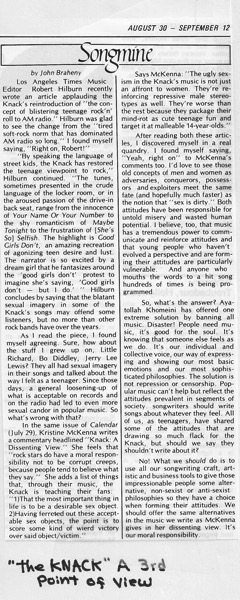
Accession Number: C000000137-022-001 Document/Digital File, “Songmine: For the non-writing artist: Where do you find original material by John Braheny”, OCR converted text under same Accession Number
(Digitally converted text. Some errors may occur)
AUGUST 30 — SEPTEMBER 12
Songmine by John Braheny
Los Angeles Times Music Editor Robert Hilburn recently wrote an article applauding the Knack’s reintroduction of “the con-cept of blistering teenage rock’n’ roll to AM radio.” Hilburn was glad to see the change from the “tired soft-rock norm that has dominated AM radio so long.” I found myself saying, “Right on, Robert!”
“By speaking the language of street kids, the Knack has restored the teenage viewpoint to rock,” Hilburn continued. “The tunes, sometimes presented in the crude language of the locker room, or in the aroused passion of the drive-in back seat, range from the innocence of Your Name Or Your Number to the shy romanticism of Maybe Tonight to the frustration of [She’s So] Selfish. The highlight is Good Girls Don’t, an amazing recreation of agonizing teen desire and lust. The narrator is so excited by a dream girl that he fantasizes around the ‘good girls don’t’ protest to imagine she’s saying, ‘Good girls don’t — but I do.’ ” Hilburn concludes by saying that the blatant sexual imagery in some of the Knack’s songs may offend some listeners, but no more than other rock bands have over the years.
As I read the piece, I found myself agreeing. Sure, how about the stuff I grew up on, Little Richard, Bo Diddley, Jerry Lee Lewis? They all had sexual imagery in their songs and talked about the way I felt as a teenager. Since those days, a general loosening-up of what is acceptable on records and on the radio had led to even more sexual candor in popular music. So what’s wrong with that?
In the same issue of Calendar (July 29), Kristine McKenna writes a commentary headlined “Knack: A Dissenting View.” She feels that “rock stars do have a moral respon-sibility not to be corrupt creeps, because people tend to believe what they say.” She adds a list of things that, through their music, the Knack is teaching their fans: “1)That the most important thing in life is to be a desirable sex object. 2)Having ferreted out these accept-able sex objects, the point is to score some kind of wierd victory over said object/victim.”
Says McKenna: “The ugly sex-ism in the Knack’s music is not just an affront to women. They’re re-inforcing repressive male stereo-types as well. They’re worse than the rest because they package their mind-rot as cute teenage fun and target it at malleable 14-year-olds.”
After reading both these artic-les, I discovered myself in a real quandry. I found myself saying, “Yeah, right on” to McKenna’s comments too. I’d love to see those old concepts of men and women as adversaries, conquerors, possess-ors and exploiters meet the same fate (and hopefully much faster) as the notion that “sex is dirty.” Both attitudes have been responsible for untold misery and wasted human potential. I believe, too, that music has a tremendous power to comm-unicate and reinforce attitudes and that young people who haven’t evolved a perspective and are form-ing their attitudes are particularly vulnerable. And anyone who mouths the words to a hit song hundreds of times is being pro-grammed.
So, what’s the answer? Aya-tollah Khomeini has offered one extreme solution by banning all music. Disaster! People need mu-sic, it’s good for the soul. It’s knowing that someone else feels as we do. It’s our individual and collective voice, our way of express-ing and showing our most basic emotions and our most sophis-ticated philosophies. The solution is not repression or censorship. Pop-ular music can’t help but reflect the attitudes prevalent in segments of society. songwriters should write songs about whatever they feel. All of us, as teenagers, have shared some of the attitudes that are drawing so much flack for the Knack, but should we say they shouldn’t write about it?
No! What we should do is to use all our songwriting craft, art-istic and business tools to give those impressionable people some alter-native, non-sexist or anti-sexist philosophies so they have a choice when forming their attitudes. We should offer the same alternatives in the music we write as McKenna gives in her dissenting view. It’s our moral responsibility.
Previously in the Songmine Collection:
- Songmine: For the non-writing artist: Where do you find original material? by John Braheny
- Songmine: For the non-writing artist: Why you need original material by John Braheny
- Songmine: Scoring Films on a Low Budget Part 6 by John Braheny
- Scoring Films on a Low Budget Part 5 by John Braheny
- Songmine: Scoring Films on a Low Budget Part 4 by John Braheny
- Songmine: Scoring Films on a Low Budget Part 3 by John Braheny
- Songmine: Scoring Films on a Low Budget Part 2: Research and Spotting
- Songmine: Scoring Films on a Low Budget Part 1
- Songmine: The Chances for Advances by John Braheny
- Songmine: What a Record Company Needs to Know – Part 6: Attorneys by John Braheny
- Songmine: What a Record Company Needs to Know – Part 5: The Professional Team by John Braheny
- Songmine: What a Record Company Needs to Know – Part 4: What Makes This Act Marketable? by John Braheny
- Songmine: What A Record Company Needs to Know : Part 3
- Songmine: What A Record Company Needs to Know: Part 2 by John Braheny
- Songmine: What A Record Company Needs to Know: Part 1 by John Braheny
- Songmine: Getting the Most from the Trades Part 4
- Songmine: Getting the Most from the Trades Part 3 by John Braheny
- Getting the Most from the Trades
- Songmine: Publishing III
- Songmine: Leave Your Ego at the Door
- Songmine: “Feedback: Why some publishers won’t give it”
- Songmine: Dealing with Rejection by John Braheny
- “Music in Print” – A Songmine Column from Music Connection Magazine March 19-April 1, 1981
About Songmine and Music Connection Magazine:
John Braheny met Eric Bettelli and Michael Dolan right before they were going to publish Music Connection magazine. Eric and Michael wanted to get their publication out to as many songwriters as they could. They had already heard of the LA Songwriters Showcase, and of John and his partner, Len Chandler. John’s goal was to advertise the schedule of guest speakers and performers at the weekly Showcase… so they made a deal.
They published John’s Songmine column (he had never before written a magazine article!) in their very first edition, in November 1977. Trading out the column for advertising, this arrangement continued for many years. Plus, Eric and Michael came to the Showcase each week and distributed free copies to the songwriters!
Those articles became so popular that (book agent and editor) Ronny Schiff offered John’s articles to F&W Media, where they became the backbone of John’s textbook, The Craft and Business of Songwriting. As a follow-up, Dan Kimpel (author, songwriter, teacher), who had also worked at LASS, took on the Songwriting column at Music Connection magazine which continues to this day! You can subscribe to get either hard copies or online.
Songwriters Musepaper – Volume 6 Issue 4 – April 1991 – Interview: Dean Pitchford
Songwriters Musepaper – Volume 6 Issue 4 – April 1991 – Interview: Dean Pitchford
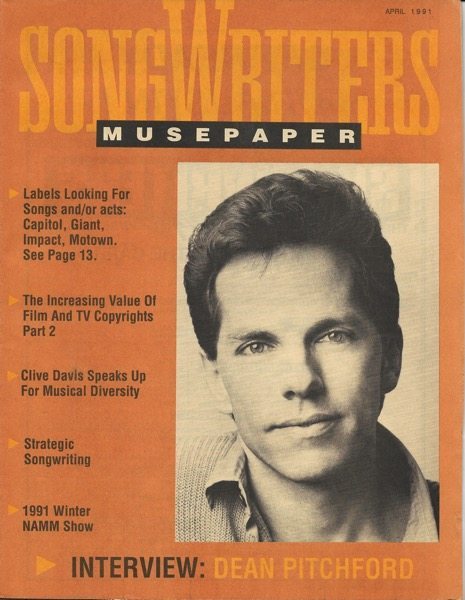
JB#: C000000062-022-001
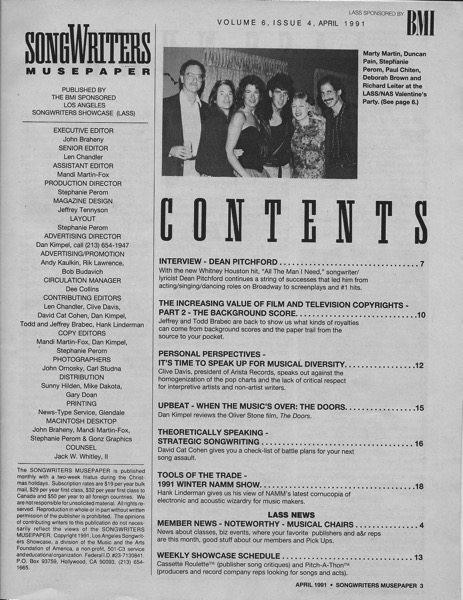
JB #: C000000062-022-002
Table of Contents
(Digitally converted text. Some errors may occur)
INTERVIEW – DEAN PITCHFORD 7
With the new Whitney Houston hit, “All The Man I Need,” songwriter/ lyricist Dean Pitchford continues a string of successes that led him from acting/singing/dancing roles on Broadway to screenplays and #1 hits.
THE INCREASING VALUE OF FILM AND TELEVISION COPYRIGHTS -PART 2 – THE BACKGROUND SCORE 10
Jeffrey and Todd Brabec are back to show us what kinds of royalties can come from background scores and the paper trail from the source to your pocket.
PERSONAL PERSPECTIVES – IT’S TIME TO SPEAK UP FOR MUSICAL DIVERSITY 12
Clive Davis, president of Arista Records, speaks out against the homogenization of the pop charts and the lack of critical respect for interpretive artists and non-artist writers.
UPBEAT – WHEN THE MUSIC’S OVER: THE DOORS 15
Dan Kimpel reviews the Oliver Stone film, The Doors.
THEORETICALLY SPEAKING -STRATEGIC SONGWRITING 16
David Cat Cohen gives you a check-list of battle plans for your next song assault.
TOOLS OF THE TRADE-1991 WINTER NAMM SHOW 18
Hank Linderman gives us his view of NAMM’s latest cornucopia of electronic and acoustic wizardry for music makers.
LASS NEWS
MEMBER NEWS – NOTEWORTHY – MUSICAL CHAIRS 4
News about classes, biz events, where your favorite publishers and a&r reps are this month, good stuff about our members and Pick Ups.
WEEKLY SHOWCASE SCHEDULE 13
Cassette RouletteTM (publisher song critiques) and Pitch-A-ThonTM (producers and record company reps looking for songs and acts).
APRIL 1991 • SONGWRITERS MUSEPAPER 3
From the Acting Archivist…
Much like the Songmine columns posted earlier, the archives contain a large collection of Songwriter Musepaper publications. With this posting, I am beginning a project to scan the cover and table of contents of each issue and then OCR (convert the scanned picture to text) the table of contents in order to make it searchable. I don’t yet have the staff necessary to create complete scanned issues of the Museupaper, but if there is interest in a particular article or interview, I can scan that and make it available here.
Douglas E. Welch, douglas@welchwrite.com
Previously in Songwriters Musepaper:
- Songwriters Musepaper – Volume 10 Issue 1 – January 1995 – Interview: Stephanie Davis
- Songwriters Musepaper – Volume 12 Issue 1 – January 1997 – Interview: Skip Ewing
- Songwriters Musepaper – Volume 3 Issue 11 – October-November 1988 – Interview: Jules Shear
- Songwriters Musepaper – Volume 4 Issue 5 – May 1989 – Interview: Lyle Lovett
- Songwriters Musepaper – Volume 11 Issue 12 December 1996 – Interview: Allan Rich
- Songwriters Musepaper – Volume 6 Issue 1 – January 1991 – Interview: Fee Waybill
- Songwriters Musepaper – Volume 4 Issue 1 – January 1989 – Interview: Steve Lukather: Major Guitar Talks Major Songs
- Songwriters Musepaper – Volume 5 Issue 9 – September 1990 – Interview: Desmond Child
- Songwriters Musepaper – Volume 7 Issue 4 – April 1992- Interview: Thom Bell
- Songwriters Musepaper – Volume 7 Issue 7 – July 1992 – Interview: Robert Byrne
- Songwriters Musepaper – Volume 6 Issue 3 – March 1991 – Interview: Alan Silvestri
- Songwriters Musepaper – Volume 5 Issue 4 – April 1990 – Interview: Michael Jay
- Songwriters Musepaper – Volume 5 Issue 10 – October 1990 – Songwriters Expo 14 – Interview: Glen Ballard
- Songwriters Musepaper – Volume 6 Issue 10 – October 1991 – Interview: Dewayne Blackwell
- Songwriters Musepaper – Volume 7 Issue 9 – September 1992 – Songwriters Expo 16 – Interview: Jennifer Warnes
- Songwriters Musepaper – Volume 8 Issue 10 – October 1993 – Cover: Charles John Quarto and Pete Wasner
- Songwriters Musepaper – Volume 8 Issue 8 – August 1993 – Cover: Interview: Janis Ian
- Songwriters Musepaper – Volume 7 Issue 10 – October 1992 – Cover: Interview: John Trudell
Songmine: For the non-writing artist: Where do you find original material? by John Braheny
A John Braheny Songmine column from the archives…
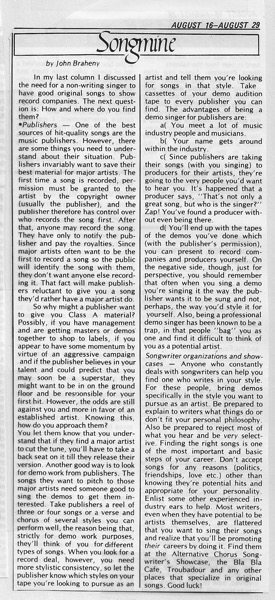
Accession Number: C000000137-021-002 Document/Digital File, “Songmine: For the non-writing artist: Where do you find original material by John Braheny”, OCR converted text under same Accession Number
(Digitally converted text. Some errors may occur)
AUGUST 16—AUGUST 29
Songmine by John Braheny
In my last column I discussed the need for a non-writing singer to have good original songs to show record companies. The next quest-ion is: How and where do you find them?
•Publishers — One of the best sources of hit-quality songs are the music publishers. However, there are some things you need to under-stand about their situation. Pub-lishers invariably want to save their best material for major artists. The first time a song is recorded, per-mission must be granted to the artist by the copyright owner (usually the publisher), and the publisher therefore has control over who records the song first. After that, anyone may record the song. They have only to notify the pub-lisher and pay the royalties. Since major artists often want to be the first to record a song so the public will identify the song with them, they don’t want anyone else record-ing it. That fact will make publish-ers reluctant to give you a song they’d rather have a major artist do.
So why might a publisher want to give you Class A material? Possibly, if you have management and are getting masters or demos. together to shop to labels, if you appear to have some momentum by virtue of an aggressive campaign and if the publisher believes in your talent and could predict that you may soon be a superstar, they might want to be in on the ground floor and be resuonsible for your first hit. However, the odds are still against you and more in favor of an established artist. Knowing this, how do you approach them? You let them know that you under-stand that if they find a major artist to cut the tune, you’ll have to take a back seat on it till they release their version. Another good way is to look for demo work from publishers. The songs they want to pitch to those major artists need someone good to sing the demos to get them in-terested. Take publishers a reel of three or four songs or a verse and chorus of several styles you can perform well, the reason being that, strictly for demo work purposes, they’ll think of you for different types of songs. When you look for a record deal, however, you need more stylistic consistency, so let the publisher know which styles on your tape you’re looking to pursue as an
artist and tell them you’re looking for songs in that style. Take cassettes of your demo audition tape to every publisher you can find. The advantages of being a demo singer for publishers are:
a( You meet a lot of music industry people and musicians.
b( Your name gets around within the industry.
c( Since publishers are taking their songs (with you singing) to producers for their artists, they’re going to the very people you’d want to hear you. It’s happened that a producer says, “That’s not only a great song, but who is the singer?” Zap! You’ve found a producer with-out even being there.
d( You’ll end up with the tapes of the demos you’ve done which (with the publisher’s permission), you can present to record com-panies and producers yourself. On the negative side, though, just for perspective, you should remember that often when you sing a demo you’re singing it the way the pub-lisher wants it to be sung and not, perhaps, the way you’d style it for yourself. Also, being a professional demo singer has been known to be a trap, in that people “bag” you as one and find it difficult to think of you as a potential artist.
Songwriter organizations and show-cases — Anyone who constantly deals with songwriters can help you find one who writes in your style. For these people, bring demos specifically in the style you want to pursue as an artist. Be prepared to explain to writers what things do or don’t fit your personal philosophy. Also be prepared to reject most of what you hear and be very select-ive. Finding the right songs is one of the most important and basic steps of your career. Don’t accept songs for any reasons (politics, friendships, love etc.) other than knowing they’re potential hits and appropriate for your personality. Enlist some other experienced in-dustry ears to help. Most writers, even when they have potential to be artists themselves, are flattered that you want to sing their songs and realize that you’ll be promoting their careers by doing it. Find them at the Alternative Chorus Song-writer’s Showcase, the Bla Bla Cafe, Troubadour and any other places that specialize in original songs. Good luck!
Previously in the Songmine Collection:
- Songmine: For the non-writing artist: Why you need original material by John Braheny
- Songmine: Scoring Films on a Low Budget Part 6 by John Braheny
- Scoring Films on a Low Budget Part 5 by John Braheny
- Songmine: Scoring Films on a Low Budget Part 4 by John Braheny
- Songmine: Scoring Films on a Low Budget Part 3 by John Braheny
- Songmine: Scoring Films on a Low Budget Part 2: Research and Spotting
- Songmine: Scoring Films on a Low Budget Part 1
- Songmine: The Chances for Advances by John Braheny
- Songmine: What a Record Company Needs to Know – Part 6: Attorneys by John Braheny
- Songmine: What a Record Company Needs to Know – Part 5: The Professional Team by John Braheny
- Songmine: What a Record Company Needs to Know – Part 4: What Makes This Act Marketable? by John Braheny
- Songmine: What A Record Company Needs to Know : Part 3
- Songmine: What A Record Company Needs to Know: Part 2 by John Braheny
- Songmine: What A Record Company Needs to Know: Part 1 by John Braheny
- Songmine: Getting the Most from the Trades Part 4
- Songmine: Getting the Most from the Trades Part 3 by John Braheny
- Getting the Most from the Trades
- Songmine: Publishing III
- Songmine: Leave Your Ego at the Door
- Songmine: “Feedback: Why some publishers won’t give it”
- Songmine: Dealing with Rejection by John Braheny
- “Music in Print” – A Songmine Column from Music Connection Magazine March 19-April 1, 1981
About Songmine and Music Connection Magazine:
John Braheny met Eric Bettelli and Michael Dolan right before they were going to publish Music Connection magazine. Eric and Michael wanted to get their publication out to as many songwriters as they could. They had already heard of the LA Songwriters Showcase, and of John and his partner, Len Chandler. John’s goal was to advertise the schedule of guest speakers and performers at the weekly Showcase… so they made a deal.
They published John’s Songmine column (he had never before written a magazine article!) in their very first edition, in November 1977. Trading out the column for advertising, this arrangement continued for many years. Plus, Eric and Michael came to the Showcase each week and distributed free copies to the songwriters!
Those articles became so popular that (book agent and editor) Ronny Schiff offered John’s articles to F&W Media, where they became the backbone of John’s textbook, The Craft and Business of Songwriting. As a follow-up, Dan Kimpel (author, songwriter, teacher), who had also worked at LASS, took on the Songwriting column at Music Connection magazine which continues to this day! You can subscribe to get either hard copies or online.
Songwriters Musepaper – Volume 10 Issue 1 – January 1995 – Interview: Stephanie Davis
Songwriters Musepaper – Volume 10 Issue 1 – January 1995 – Interview: Stephanie Davis

JB#: C000000062-021-001
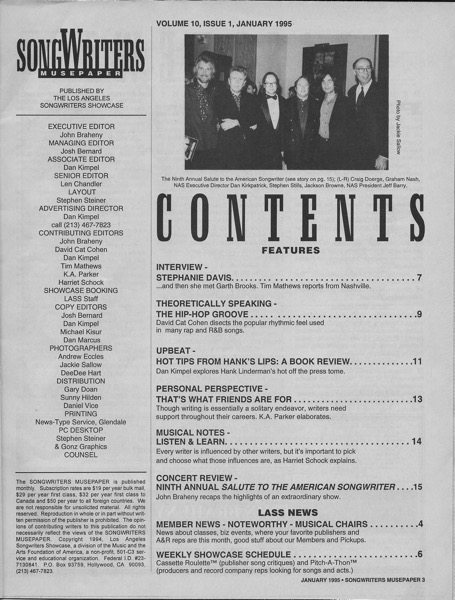
JB #: C000000062-021-002
Table of Contents
(Digitally converted text. Some errors may occur)
INTERVIEW -STEPHANIE DAVIS 7
…and then she met Garth Brooks. Tim Mathews reports from Nashville.
THEORETICALLY SPEAKING -THE HIP-HOP GROOVE 9
David Cat Cohen disects the popular rhythmic feel used in many rap and R&B songs.
UPBEAT-HOT TIPS FROM HANK’S LIPS: A BOOK REVIEW 11
Dan Kimpel explores Hank Linderman’s hot off the press tome.
PERSONAL PERSPECTIVE -THAT’S WHAT FRIENDS ARE FOR 13
Though writing is essentially a solitary endeavor, writers need support throughout their careers. K.A. Parker elaborates.
MUSICAL NOTES -LISTEN & LEARN 14
Every writer is influenced by other writers, but it’s important to pick and choose what those influences are, as Harriet Schock explains.
CONCERT REVIEW -NINTH ANNUAL SALUTE TO THE AMERICAN SONGWRITER . . . .15
John Braheny recaps the highlights of an extraordinary show.
LASS NEWS MEMBER NEWS – NOTEWORTHY – MUSICAL CHAIRS 4
News about classes, biz events, where your favorite publishers and A&R reps are this month, good stuff about our Members and Pickups.
WEEKLY SHOWCASE SCHEDULE 6
Cassette RouletteTM (publisher song critiques) and Pitch-A-ThonTm (producers and record company reps looking for songs and acts.)
JANUARY 1995 • SONGWRITERS MUSEPAPER 3
From the Acting Archivist…
Much like the Songmine columns posted earlier, the archives contain a large collection of Songwriter Musepaper publications. With this posting, I am beginning a project to scan the cover and table of contents of each issue and then OCR (convert the scanned picture to text) the table of contents in order to make it searchable. I don’t yet have the staff necessary to create complete scanned issues of the Museupaper, but if there is interest in a particular article or interview, I can scan that and make it available here.
Douglas E. Welch, douglas@welchwrite.com
Previously in Songwriters Musepaper:
- Songwriters Musepaper – Volume 12 Issue 1 – January 1997 – Interview: Skip Ewing
- Songwriters Musepaper – Volume 3 Issue 11 – October-November 1988 – Interview: Jules Shear
- Songwriters Musepaper – Volume 4 Issue 5 – May 1989 – Interview: Lyle Lovett
- Songwriters Musepaper – Volume 11 Issue 12 December 1996 – Interview: Allan Rich
- Songwriters Musepaper – Volume 6 Issue 1 – January 1991 – Interview: Fee Waybill
- Songwriters Musepaper – Volume 4 Issue 1 – January 1989 – Interview: Steve Lukather: Major Guitar Talks Major Songs
- Songwriters Musepaper – Volume 5 Issue 9 – September 1990 – Interview: Desmond Child
- Songwriters Musepaper – Volume 7 Issue 4 – April 1992- Interview: Thom Bell
- Songwriters Musepaper – Volume 7 Issue 7 – July 1992 – Interview: Robert Byrne
- Songwriters Musepaper – Volume 6 Issue 3 – March 1991 – Interview: Alan Silvestri
- Songwriters Musepaper – Volume 5 Issue 4 – April 1990 – Interview: Michael Jay
- Songwriters Musepaper – Volume 5 Issue 10 – October 1990 – Songwriters Expo 14 – Interview: Glen Ballard
- Songwriters Musepaper – Volume 6 Issue 10 – October 1991 – Interview: Dewayne Blackwell
- Songwriters Musepaper – Volume 7 Issue 9 – September 1992 – Songwriters Expo 16 – Interview: Jennifer Warnes
- Songwriters Musepaper – Volume 8 Issue 10 – October 1993 – Cover: Charles John Quarto and Pete Wasner
- Songwriters Musepaper – Volume 8 Issue 8 – August 1993 – Cover: Interview: Janis Ian
- Songwriters Musepaper – Volume 7 Issue 10 – October 1992 – Cover: Interview: John Trudell
Songmine: For the non-writing artist: Why you need original material by John Braheny
A John Braheny Songmine column from the archives…
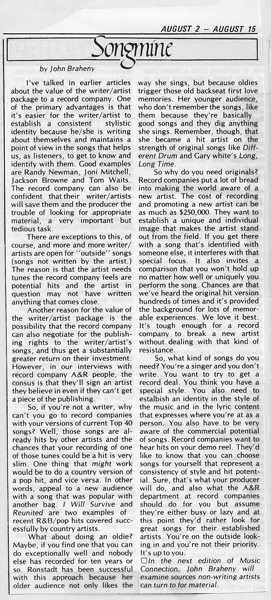
Accession Number: C000000137-021-001 Document/Digital File, “Songmine: For the non-writing artist: Why you need original material by John Braheny”, OCR converted text under same Accession Number
(Digitally converted text. Some errors may occur)
AUGUST 2 — AUGUST 15
Songmine by John Braheny
For the non-writing artist: Why you need original material
I’ve talked in earlier articles about the value of the writer/artist package to a record company. One of the primary advantages is that it’s easier, for the writer/artist to establish a consistent stylistic identity because he/she is writing about themselves and maintains a point of view in the songs that helps us, as listeners, to get to know and identify with them. Good examples are Randy Newman, Joni Mitchell, Jackson Browne and Tom Waits. The record company can also be confident that their writer/artists will save them and the producer the trouble of looking for appropriate material, a very important but tedious task.
There are exceptions to this, of course, and more and more writer/ artists are open for “outside” songs (songs not written by the artist.) The reason is that the artist needs tunes the record company feels are potential hits and the artist in question may not have written anything that comes close. Another reason for the value of the writer/artist package is the possibility that the record company can also negotiate for the publish-ing rights to the writer/artist’s songs, and thus get a substantially greater return on their investment. However, in our interviews with record company A&R people, the consus is that they’ll sign an artist they believe in even if they can’t get a piece of the publishing.
So, if you’re not a writer, why can’t you go to record companies with your versions of current Top 40 songs? Well, those songs are al-ready hits by other artists and the chances that your recording of one of those tunes could be a hit is very slim. One thing that might work would be to do a country version of a pop hit, and vice versa. In other words, appeal to a new audience with a song that was popular with another bag. I Will Survive and Reunited are two examples of recent R&B/pop hits covered succ-essfully by country artists.
What about doing an oldie? Maybe, if you find one that you can do exceptionally well and nobody else has recorded for ten years or so. Ronstadt has been successful with this approach because her older audience not only likes the way she sings, but because oldies trigger those old backseat first love memories. Her younger audience, who don’t remember the songs, like them because they’re basically good songs and they dig anything she sings. Remember, though, that she became a hit artist on the strength of original songs like Diff-erent Drum and Gary white’s Long, Long Time.
So why do you need originals? Record companies put a lot of bread into making the world aware of a new artist. The cost of recording and promoting a new artist can be as much as $250,000. They want to establish a unique and individual image that makes the artist stand out from the field. If you get there with a song that’s identified with someone else, it interferes with that special focus. It also invites a comparison that you won’t hold up no matter how well or uniquely you perform the song. Chances are that we’ve heard the original hit version hundreds of times and it’s provided the background for lots of memor-able experiences. We love it best. It’s tough enough for a record company to break a new artist without dealing with that kind of resistance.
So, what kind of songs do you need? You’re a singer and you don’t write. You want to try to get a record deal. You think you have a special style. You also need to estalbish an identity in the style of the music and in the lyric content that expresses where you’re at as a person. You also have to be very aware of the commercial potential of songs. Record companies want to hear hits on your demo reel. They’d like to know that you can choose songs for yourself that represent a consistency of style and hit potent-ial. Sure, that’s what your producer will do, and also what the A&R department at record companies should do for you but assume they’re either busy or lazy and at this point they’d rather look for great songs for their established artists. You’re on the outside look-ing in and you’re not their priority. It’s up to you.
ln the next edition of Music Connection, John Braheny will examine sources non-writing artists can turn to for material.
Previously in the Songmine Collection:
- Songmine: Scoring Films on a Low Budget Part 6 by John Braheny
- Scoring Films on a Low Budget Part 5 by John Braheny
- Songmine: Scoring Films on a Low Budget Part 4 by John Braheny
- Songmine: Scoring Films on a Low Budget Part 3 by John Braheny
- Songmine: Scoring Films on a Low Budget Part 2: Research and Spotting
- Songmine: Scoring Films on a Low Budget Part 1
- Songmine: The Chances for Advances by John Braheny
- Songmine: What a Record Company Needs to Know – Part 6: Attorneys by John Braheny
- Songmine: What a Record Company Needs to Know – Part 5: The Professional Team by John Braheny
- Songmine: What a Record Company Needs to Know – Part 4: What Makes This Act Marketable? by John Braheny
- Songmine: What A Record Company Needs to Know : Part 3
- Songmine: What A Record Company Needs to Know: Part 2 by John Braheny
- Songmine: What A Record Company Needs to Know: Part 1 by John Braheny
- Songmine: Getting the Most from the Trades Part 4
- Songmine: Getting the Most from the Trades Part 3 by John Braheny
- Getting the Most from the Trades
- Songmine: Publishing III
- Songmine: Leave Your Ego at the Door
- Songmine: “Feedback: Why some publishers won’t give it”
- Songmine: Dealing with Rejection by John Braheny
- “Music in Print” – A Songmine Column from Music Connection Magazine March 19-April 1, 1981
About Songmine and Music Connection Magazine:
John Braheny met Eric Bettelli and Michael Dolan right before they were going to publish Music Connection magazine. Eric and Michael wanted to get their publication out to as many songwriters as they could. They had already heard of the LA Songwriters Showcase, and of John and his partner, Len Chandler. John’s goal was to advertise the schedule of guest speakers and performers at the weekly Showcase… so they made a deal.
They published John’s Songmine column (he had never before written a magazine article!) in their very first edition, in November 1977. Trading out the column for advertising, this arrangement continued for many years. Plus, Eric and Michael came to the Showcase each week and distributed free copies to the songwriters!
Those articles became so popular that (book agent and editor) Ronny Schiff offered John’s articles to F&W Media, where they became the backbone of John’s textbook, The Craft and Business of Songwriting. As a follow-up, Dan Kimpel (author, songwriter, teacher), who had also worked at LASS, took on the Songwriting column at Music Connection magazine which continues to this day! You can subscribe to get either hard copies or online.
Songwriters Musepaper – Volume 12 Issue 1 – January 1997 – Interview: Skip Ewing
Songwriters Musepaper – Volume 12 Issue 1 – January 1997 – Interview: Skip Ewing
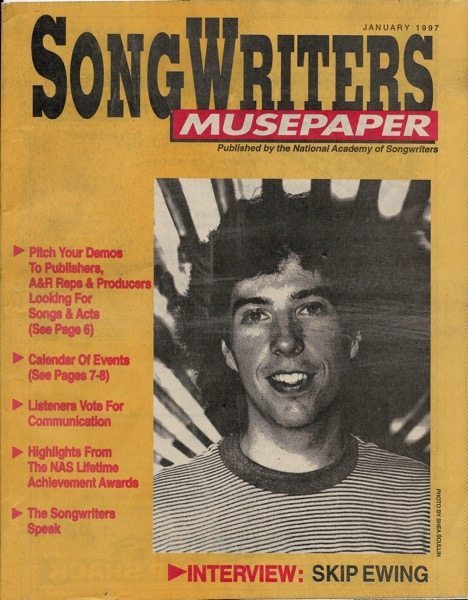
JB#: C000000062-020-001
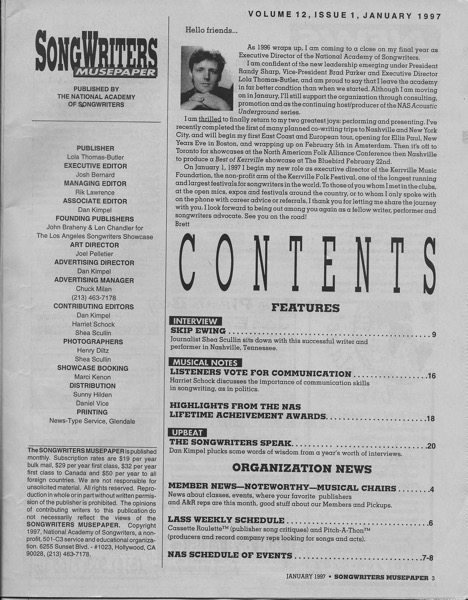
JB #: C000000062-020-002
Table of Contents
(Digitally converted text. Some errors may occur)
INTERVIEW
SKIP EWING 9
Journalist Shea Scullin sits down with this successful writer and performer in Nashville, Tennessee.
MUSICAL NOTES
LISTENERS VOTE FOR COMMUNICATION 16
Harriet Schock discusses the importance of communication skills in songwriting, as in politics.
HIGHLIGHTS FROM THE NAS LIFETIME ACHEIVEMENT AWARDS 18
UPBEAT
THE SONGWRITERS SPEAK 20
Dan Kimpel plucks some words of wisdom from a year’s worth of interviews.
ORGANIZATION NEWS
MEMBER NEWS-NOTEWORTHY-MUSICAL CHAIRS 4
News about classes, events, where your favorite publishers and A&R reps are this month, good stuff about our Members and Pickups.
LASS WEEKLY SCHEDULE 6
Cassette RouletteTM (publisher song critiques) and Pitch-A-ThonTm (producers and record company reps looking for songs and acts).
NAS SCHEDULE OF EVENTS 7-8
JANUARY 1997 • SONGWRITERS MUSEPAPER 3
From the Acting Archivist…
Much like the Songmine columns posted earlier, the archives contain a large collection of Songwriter Musepaper publications. With this posting, I am beginning a project to scan the cover and table of contents of each issue and then OCR (convert the scanned picture to text) the table of contents in order to make it searchable. I don’t yet have the staff necessary to create complete scanned issues of the Museupaper, but if there is interest in a particular article or interview, I can scan that and make it available here.
Douglas E. Welch, douglas@welchwrite.com
Previously in Songwriters Musepaper:
- Songwriters Musepaper – Volume 3 Issue 11 – October-November 1988 – Interview: Jules Shear
- Songwriters Musepaper – Volume 4 Issue 5 – May 1989 – Interview: Lyle Lovett
- Songwriters Musepaper – Volume 11 Issue 12 December 1996 – Interview: Allan Rich
- Songwriters Musepaper – Volume 6 Issue 1 – January 1991 – Interview: Fee Waybill
- Songwriters Musepaper – Volume 4 Issue 1 – January 1989 – Interview: Steve Lukather: Major Guitar Talks Major Songs
- Songwriters Musepaper – Volume 5 Issue 9 – September 1990 – Interview: Desmond Child
- Songwriters Musepaper – Volume 7 Issue 4 – April 1992- Interview: Thom Bell
- Songwriters Musepaper – Volume 7 Issue 7 – July 1992 – Interview: Robert Byrne
- Songwriters Musepaper – Volume 6 Issue 3 – March 1991 – Interview: Alan Silvestri
- Songwriters Musepaper – Volume 5 Issue 4 – April 1990 – Interview: Michael Jay
- Songwriters Musepaper – Volume 5 Issue 10 – October 1990 – Songwriters Expo 14 – Interview: Glen Ballard
- Songwriters Musepaper – Volume 6 Issue 10 – October 1991 – Interview: Dewayne Blackwell
- Songwriters Musepaper – Volume 7 Issue 9 – September 1992 – Songwriters Expo 16 – Interview: Jennifer Warnes
- Songwriters Musepaper – Volume 8 Issue 10 – October 1993 – Cover: Charles John Quarto and Pete Wasner
- Songwriters Musepaper – Volume 8 Issue 8 – August 1993 – Cover: Interview: Janis Ian
- Songwriters Musepaper – Volume 7 Issue 10 – October 1992 – Cover: Interview: John Trudell
Songmine: Scoring Films on a Low Budget Part 6 by John Braheny
A John Braheny Songmine column from the archives…
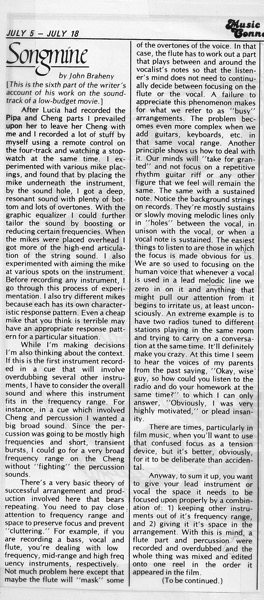
Accession Number: C000000137-020-002 Document/Digital File, “Songmine: Scoring Films on a Low Budget Part 6 by John Braheny”, OCR converted text under same Accession Number
(Digitally converted text. Some errors may occur)
JULY 5 — JULY 18
Songmine by John Braheny
[This is the sixth part of the writer’s account of his work on the sound-track of a low-budget movie.]
After Lucia had recorded the Pipa and Cheng parts I prevailed upon her to leave her Cheng with me and I recorded a lot of stuff by myself using a remote control on the four-track and watching a stop-watch at the same time. I ex-perimented with various mike plac-ings, and found that by placing the mike underneath the instrument, by the sound hole, I got a deep, resonant sound with plenty of bot-tom and lots of overtones. With the graphic equalizer I could further tailor the sound by boosting or reducing certain frequencies. When the mikes were placed overhead I got more of the high-end articula-tion of the string sound. I also experimented with aiming the mike at various spots on the instrument. Before recording any instrument, I go through this process of experi-mentation. I also try different mikes because each has its own character-istic response pattern. Even a cheap mike that you think is terrible may have an appropriate response patt-ern for a particular situation.
While I’m making decisions I’m also thinking about the context. If this is the first instrument record-ed in a cue that will involve overdubbing several other instru-ments, I have to consider the overall sound and where this instrument fits in the frequency range. For instance, in a cue which involved Cheng and percussion I wanted a big broad sound. Since the per-cussion was going to be mostly high frequencies and short, transient bursts, I could go for a very broad frequency range on the Cheng without “fighting” the percussion sounds.
There’s a very basic theory of successful arrangement and prod-uction involved here that bears repeating. You need to pay close attention to frequency range and space to preserve focus and prevent “cluttering.” For example, if you are recording a bass, vocal and flute, you’re dealing with low frequency, mid-range and high frequency instruments, respectively. Not much problem here except that maybe the flute will “mask” some of the overtones of the voice. In that case, the flute has to work out a part that plays between and around the vocalist’s notes so that the listen-er’s mind does not need to continu-ally decide between focusing on the flute or the vocal. A failure to appreciate this phenomenon makes for what we refer to as “busy” arrangements. The problem bec-omes even more complex when we add guitars, keyboards, etc. in that same vocal range. Another principle shows us how to deal with it. Our minds will “take for gran-ted” and not focus on a repetitive rhythm guitar riff or any other figure that we feel will remain the same. The same with a sustained note. Notice the background strings on records. They’re mostly sustains or slowly moving melodic lines only in “holes” between the vocal, in unison with the vocal, or when a vocal note is sustained. The easiest things to listen to are those in which the focus is made obvious for us. We are so used to focusing on the human voice that whenever a vocal is used in a lead melodic line we zero in on it and anything that might pull our attention from it begins to irritate us, at least uncon-sciously. An extreme example is to have two radios tuned to different stations playing in the same room and trying to carry on a conversa-tion at the same time. It’ll definitely make you crazy. At this time I seem to hear the voices of my parents from the past saying, “Okay, wise’ guy, so how could you listen to the radio and do your homework at the same time?” to which I can only answer, “Obviously, I was very highly motivated,” or plead insan-ity.
There are times, particularly in film music, when you’ll want to use that confused focus as a tension device, but it’s better, obviously, for it to be deliberate than accidental.
Anyway, to sum it up, you want to give your lead instrument or vocal the space it needs to be focused upon properly by a combin-ation of: 1) keeping other instru-ments out of it’s frequency range, and 2) giving it it’s space in the arrangement. With this is mind, a flute part and percussion_ were recorded and overdubbed and the whole thing was mixed and edited onto one reel in the order it appeared in the film.
(To be continued.)
Previously in the Songmine Collection:
- Scoring Films on a Low Budget Part 5 by John Braheny
- Songmine: Scoring Films on a Low Budget Part 4 by John Braheny
- Songmine: Scoring Films on a Low Budget Part 3 by John Braheny
- Songmine: Scoring Films on a Low Budget Part 2: Research and Spotting
- Songmine: Scoring Films on a Low Budget Part 1
- Songmine: The Chances for Advances by John Braheny
- Songmine: What a Record Company Needs to Know – Part 6: Attorneys by John Braheny
- Songmine: What a Record Company Needs to Know – Part 5: The Professional Team by John Braheny
- Songmine: What a Record Company Needs to Know – Part 4: What Makes This Act Marketable? by John Braheny
- Songmine: What A Record Company Needs to Know : Part 3
- Songmine: What A Record Company Needs to Know: Part 2 by John Braheny
- Songmine: What A Record Company Needs to Know: Part 1 by John Braheny
- Songmine: Getting the Most from the Trades Part 4
- Songmine: Getting the Most from the Trades Part 3 by John Braheny
- Getting the Most from the Trades
- Songmine: Publishing III
- Songmine: Leave Your Ego at the Door
- Songmine: “Feedback: Why some publishers won’t give it”
- Songmine: Dealing with Rejection by John Braheny
- “Music in Print” – A Songmine Column from Music Connection Magazine March 19-April 1, 1981
About Songmine and Music Connection Magazine:
John Braheny met Eric Bettelli and Michael Dolan right before they were going to publish Music Connection magazine. Eric and Michael wanted to get their publication out to as many songwriters as they could. They had already heard of the LA Songwriters Showcase, and of John and his partner, Len Chandler. John’s goal was to advertise the schedule of guest speakers and performers at the weekly Showcase… so they made a deal.
They published John’s Songmine column (he had never before written a magazine article!) in their very first edition, in November 1977. Trading out the column for advertising, this arrangement continued for many years. Plus, Eric and Michael came to the Showcase each week and distributed free copies to the songwriters!
Those articles became so popular that (book agent and editor) Ronny Schiff offered John’s articles to F&W Media, where they became the backbone of John’s textbook, The Craft and Business of Songwriting. As a follow-up, Dan Kimpel (author, songwriter, teacher), who had also worked at LASS, took on the Songwriting column at Music Connection magazine which continues to this day! You can subscribe to get either hard copies or online.
Songwriters Musepaper – Volume 3 Issue 11 – October-November 1988 – Interview: Jules Shear
Songwriters Musepaper – Volume 3 Issue 11 – October-November 1988 – Interview: Jules Shear
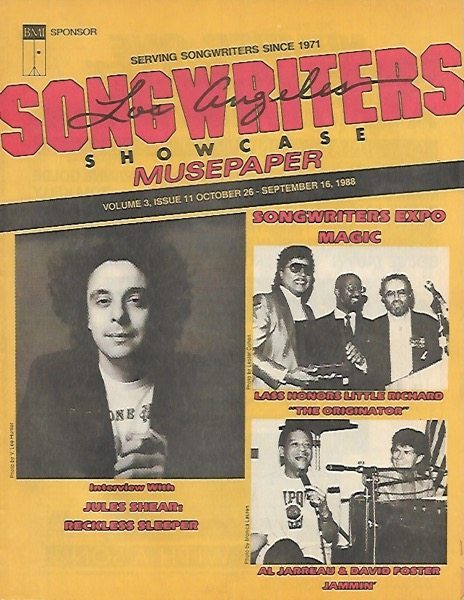
JB#: C000000062-019-001
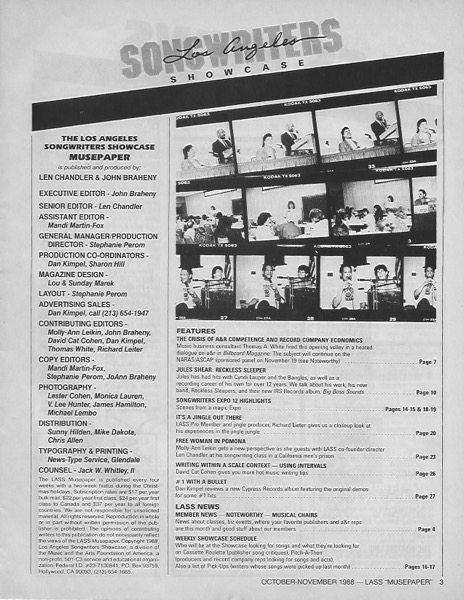
JB #: C000000062-019-002
Table of Contents
(Digitally converted text. Some errors may occur)
FEATURES
THE CRISIS OF A&R COMPETENCE AND RECORD COMPANY ECONOMICS
Music business consultant Thomas A. White fired this opening volley in a heated dialogue on a&r in Billboard Magazine. The subject will continue on the NARAS/ASCAP sponsored panel on November 19 (see Noteworthy) Page 7
JULES SHEAR: RECKLESS SLEEPER
Jules has had hits with Cyndi Lauper and the Bangles, as well as a recording career of his own for over 12 years. We talk about his work, his new band, Reckless Sleepers, and their new IRS Records album, Big Boss Sounds Page 10
SONGWRITERS EXPO 12 HIGHLIGHTS
Scenes from a magic Expo Pages 14-15 & 18-19
IT’S A JINGLE OUT THERE
LASS Pro Member and jingle producer, Richard Lieter gives us a closeup look at his experiences in the jingle jungle Page 20
FREE WOMAN IN POMONA
Molly-Ann Leikin gets a new perspective as she guests with LASS co-founder/director Len Chandler at his songwriting class in a California men’s prison Page 23
WRITING WITHIN A SCALE CONTEXT — USING INTERVALS
David Cat Cohen gives you more hot music writing tips Page 26
# 1 WITH A BULLET
Dan Kimpel reviews a new Cypress Records album featuring the original demos for some #1 hits Page 27
LASS NEWS
MEMBER NEWS — NOTEWORTHY — MUSICAL CHAIRS
News about classes, biz events, where your favorite publishers and a&r reps are this month and good stuff about our members Page 4
WEEKLY SHOWCASE SCHEDULE Who will be at the Showcase looking for songs and what they’re looking for on Cassette Roulette (publisher song critiques), Pitch-A-Thon (producers and record company reps looking for songs and acts). Also a list of Pick-Ups (writers whose songs were picked up last month) Pages 16-17
From the Acting Archivist…
Much like the Songmine columns posted earlier, the archives contain a large collection of Songwriter Musepaper publications. With this posting, I am beginning a project to scan the cover and table of contents of each issue and then OCR (convert the scanned picture to text) the table of contents in order to make it searchable. I don’t yet have the staff necessary to create complete scanned issues of the Museupaper, but if there is interest in a particular article or interview, I can scan that and make it available here.
Douglas E. Welch, douglas@welchwrite.com
Previously in Songwriters Musepaper:
- Songwriters Musepaper – Volume 4 Issue 5 – May 1989 – Interview: Lyle Lovett
- Songwriters Musepaper – Volume 11 Issue 12 December 1996 – Interview: Allan Rich
- Songwriters Musepaper – Volume 6 Issue 1 – January 1991 – Interview: Fee Waybill
- Songwriters Musepaper – Volume 4 Issue 1 – January 1989 – Interview: Steve Lukather: Major Guitar Talks Major Songs
- Songwriters Musepaper – Volume 5 Issue 9 – September 1990 – Interview: Desmond Child
- Songwriters Musepaper – Volume 7 Issue 4 – April 1992- Interview: Thom Bell
- Songwriters Musepaper – Volume 7 Issue 7 – July 1992 – Interview: Robert Byrne
- Songwriters Musepaper – Volume 6 Issue 3 – March 1991 – Interview: Alan Silvestri
- Songwriters Musepaper – Volume 5 Issue 4 – April 1990 – Interview: Michael Jay
- Songwriters Musepaper – Volume 5 Issue 10 – October 1990 – Songwriters Expo 14 – Interview: Glen Ballard
- Songwriters Musepaper – Volume 6 Issue 10 – October 1991 – Interview: Dewayne Blackwell
- Songwriters Musepaper – Volume 7 Issue 9 – September 1992 – Songwriters Expo 16 – Interview: Jennifer Warnes
- Songwriters Musepaper – Volume 8 Issue 10 – October 1993 – Cover: Charles John Quarto and Pete Wasner
- Songwriters Musepaper – Volume 8 Issue 8 – August 1993 – Cover: Interview: Janis Ian
- Songwriters Musepaper – Volume 7 Issue 10 – October 1992 – Cover: Interview: John Trudell


